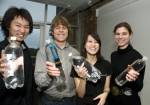The consumption of dirty water kills an estimated 4,000 children a day around the world. While water can be cheaply disinfected by exposure to sunlight, it’s hard to tell when it’s fit to drink. A new cheap solar powered tool addresses this problem.
Solar disinfection of water in plastic bottles also called SODIS, is used by millions of people around the world. The process is very simple: A clean, clear PET bottle is filled from a water source, then exposed to 6 hours of direct sun, or 12 hours of intermittent sun. The water is then safe to drink. Solar disinfection in water bottles, properly executed, offers results similar to chlorination.
But how intermittent is “intermittent”? The process does leave some questions as to whether the water has been irradiated enough by the sun’s rays.
University of Washington engineering students recently won an international contest for a design to monitor water disinfection using the sun’s rays. Using components found in a cheap solar powered calculator, the device monitors how much light is passing through the bottle and determines when enough exposure has taken place for the water to be considered safe. The UW students say the parts needed for the device would cost around $3.40 retail, and bulk purchasing could reduce the cost further.
The students are now setting up a non-profit business to make and market the device, either directly to end-users or to nonprofits that promote solar disinfection. Larger-scale systems are also being developed that could be used in scenarios such as disaster relief.
Source/Image Credit













































